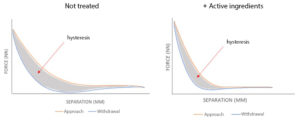CONTEXT
According to a physicist, skin is considered as a multi-layer material composed by dermis, epidermis and hypodermis. Skin mechanical properties are mainly linked to the dermis which is composed by collagen fibers networks and elastics fibers. During ageing, these fibers tend to deteriorate themselves involving loss of elasticity in aged skin.
This multi-sheets’ structure exposed to several factors (age, health, environment, gender…), has been studied and qualified as anisotrop, non-homogeneous, non-linear and viscoelastic.
Visco-elasticity allows to identify two behaviours :
● Viscosity, describing the behaviour of a viscous liquid ; this principle could be associated to hydration measurement.
●Elasticity, characterizing the behaviour of a solid having elasticity and tension properties.

WHY AFM ?
Atomic Force Microscopy (AFM) allows to characterize visco-elastic properties of biological samples as skin, before and after treatment with an active ingredient or product. AFM consists in a micro scale cantilever with a sharp tip at its end that is used to scan the surface sample and carry out visco-elasticity tests (we also can talk about dissipation energy measurements).
Typically, the deflection is measured using a laser spot reflected from the top surface of the cantilever into a photodiode (figure 2).

Figure 2 :acquisition principle of energy dissipation data with AFM
Measuring visco-elasticity allows to measure the capacity of a sample to restore its original shape. It is revealed in a clear hysteresis between the approach and retraction parts of curves ; the observations of force relaxation at constant indentation depth and the creep at constant loading force (figure 3).

Figure 3 : Hysteresis analysis
These data allow to access active ingredient’s efficacy while tissue’s mechanical properties are an important indicator of the active ingresient’s impact on skin viscoelasticity.
Follow our other news
The relationship between skin elasticity and viscoelasticity
 24 January 2024
24 January 2024Are you a smoker? Here’s how it affects your skin!
 29 November 2022
29 November 2022Why are simplicity and multifunctionality new trends in the beauty market?
 19 October 2022
19 October 2022



